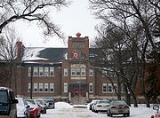
Education in Saskatchewan
Encyclopedia
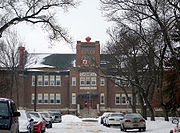
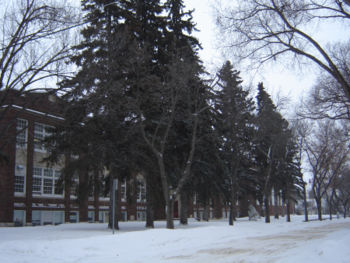
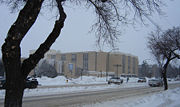
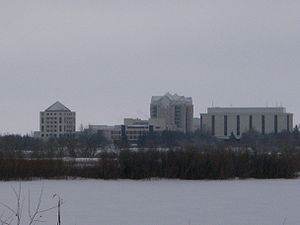
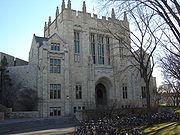
Curriculum
See also Syllabus.In formal education, a curriculum is the set of courses, and their content, offered at a school or university. As an idea, curriculum stems from the Latin word for race course, referring to the course of deeds and experiences through which children grow to become mature adults...
of learning
Learning
Learning is acquiring new or modifying existing knowledge, behaviors, skills, values, or preferences and may involve synthesizing different types of information. The ability to learn is possessed by humans, animals and some machines. Progress over time tends to follow learning curves.Human learning...
set out by the Government of Saskatchewan through the Ministry of Education. The curriculum sets out to develop skill
Skill
A skill is the learned capacity to carry out pre-determined results often with the minimum outlay of time, energy, or both. Skills can often be divided into domain-general and domain-specific skills...
s, knowledge
Knowledge
Knowledge is a familiarity with someone or something unknown, which can include information, facts, descriptions, or skills acquired through experience or education. It can refer to the theoretical or practical understanding of a subject...
, understanding
Understanding
Understanding is a psychological process related to an abstract or physical object, such as a person, situation, or message whereby one is able to think about it and use concepts to deal adequately with that object....
to improve the quality of life. June 22, 1915, Hon. Walter Scott
Walter Scott
Sir Walter Scott, 1st Baronet was a Scottish historical novelist, playwright, and poet, popular throughout much of the world during his time....
, Premier
Premier
Premier is a title for the head of government in some countries and states.-Examples by country:In many nations, "premier" is used interchangeably with "prime minister"...
and Minister of Education, set out as his mandate the "purpose of procuring for the children of Saskatchewan a better education and an education of greater service and utility to meet the conditions of the chief industry in the Province, which is agriculture”. Education facilitates the cultural and regional socialization of an individual through the realisation of their self-potential and latent talents. Historically, the region of Saskatchewan needed successful homesteaders so the focus was to develop a unified language for successful economic trading, and agricultural understanding to develop goods, livestock and cash crops to trade. After the mechanized advancements following World War II
World War II
World War II, or the Second World War , was a global conflict lasting from 1939 to 1945, involving most of the world's nations—including all of the great powers—eventually forming two opposing military alliances: the Allies and the Axis...
and the industrial revolution
Industrial Revolution
The Industrial Revolution was a period from the 18th to the 19th century where major changes in agriculture, manufacturing, mining, transportation, and technology had a profound effect on the social, economic and cultural conditions of the times...
, the primary employment agriculture sector of farming was not as labour intensive. Individuals focused on secondary industries such as manufacturing and construction, as well as tertiary employment like transportation, trade, finance and services. Schools became technologically more advanced and adapted to supply resources for this growing demand and change of focus.
Education
Education
Education in its broadest, general sense is the means through which the aims and habits of a group of people lives on from one generation to the next. Generally, it occurs through any experience that has a formative effect on the way one thinks, feels, or acts...
in Saskatchewan
Saskatchewan
Saskatchewan is a prairie province in Canada, which has an area of . Saskatchewan is bordered on the west by Alberta, on the north by the Northwest Territories, on the east by Manitoba, and on the south by the U.S. states of Montana and North Dakota....
is generally divided by Elementary
Elementary school
An elementary school or primary school is an institution where children receive the first stage of compulsory education known as elementary or primary education. Elementary school is the preferred term in some countries, particularly those in North America, where the terms grade school and grammar...
(Primary School, public school), followed by Secondary
Secondary education
Secondary education is the stage of education following primary education. Secondary education includes the final stage of compulsory education and in many countries it is entirely compulsory. The next stage of education is usually college or university...
(High School
High school
High school is a term used in parts of the English speaking world to describe institutions which provide all or part of secondary education. The term is often incorporated into the name of such institutions....
) and Post Secondary (University
University
A university is an institution of higher education and research, which grants academic degrees in a variety of subjects. A university is an organisation that provides both undergraduate education and postgraduate education...
, College
College
A college is an educational institution or a constituent part of an educational institution. Usage varies in English-speaking nations...
). Within the province under the Ministry of Education, there are district school boards administering the educational programs.
History
History of education in this region, North West TerritoriesTerritorial evolution of Canada
The federation of Canada was created in 1867 when three colonies of British North America were united. One of these colonies split into two new provinces, three other colonies joined later...
, began officially in 1885 with territorial Ordinance #5. North West Territorial Schools Districts or One Room School Houses replaced trading post schooling, missionary schools and private schooling of the past. Moose Jaw School District #1 was formally established December 5, 1884 under the new Board of Education. The 1944 School Act set out to establish larger consolidated schools and the formation of the schools and school districts presently in use. As with any Canadian province
Provinces and territories of Canada
The provinces and territories of Canada combine to make up the world's second-largest country by area. There are ten provinces and three territories...
, the Saskatchewan Legislature
Legislative Assembly of Saskatchewan
The 25th Legislative Assembly of Saskatchewan was in power from 2003 until November 20, 2007. It was controlled by the Saskatchewan New Democratic Party under premier Lorne Calvert.-Members:-By-elections:...
has (almost) exclusive authority to make laws respecting education. Since 1905 the Legislature has used this capacity to continue the model of locally elected public and separate school
Separate school
In Canada, separate school refers to a particular type of school that has constitutional status in three provinces and statutory status in three territories...
boards which originated prior to 1905, as well as to create and/or regulate universities, colleges, technical institutions and other educational forms and institutions (public charter schools, private schools, home schooling). For historians and genealogists, previous school district records have been submitted to the Saskatchewan Provincial Archives Regina Branch.
Pre-school
Pre-School in SaskatchewanSaskatchewan
Saskatchewan is a prairie province in Canada, which has an area of . Saskatchewan is bordered on the west by Alberta, on the north by the Northwest Territories, on the east by Manitoba, and on the south by the U.S. states of Montana and North Dakota....
is relatively unregulated, and is not compulsory. The first exposure many children have to learning with others outside of traditional parenting is day care
Day care
Child care or day care is care of a child during the day by a person other than the child's legal guardians, typically performed by someone outside the child's immediate family...
or a parent run playgroup
Pre-school playgroup
A pre-school playgroup, or in everyday usage just a playgroup, is an organised group providing care and socialisation for children under five. The term is widely used in the United Kingdom. Playgroups are less formal than the pre-school education of nursery schools...
. This sort of activity is not generally considered "schooling". Pre-school education is separate from primary school. Pre-schools are usually run by local councils, community groups or private organisations. Pre-school is offered to three to five year olds, although voluntary attendance numbers vary widely. The year before a child is due to attend primary school is the main year for pre-school education. This year is far more commonly attended, and usually takes the form of a few hours of activity five days a week.
Primary and secondary education
Schools providing primary education are more often referred to as elementary schools or grade schools. Primary and secondary education under the header of K-12K-12
K–12 is a designation for the sum of primary and secondary education. It is used in the United States, Canada, Australia, and New Zealand where P–12 is also commonly used...
education (K is for kindergarten
Kindergarten
A kindergarten is a preschool educational institution for children. The term was created by Friedrich Fröbel for the play and activity institute that he created in 1837 in Bad Blankenburg as a social experience for children for their transition from home to school...
, 12 is for grade 12). A system of grades is used to describe the various stages of education. Grades are generally known by cardinal
Cardinal number
In mathematics, cardinal numbers, or cardinals for short, are a generalization of the natural numbers used to measure the cardinality of sets. The cardinality of a finite set is a natural number – the number of elements in the set. The transfinite cardinal numbers describe the sizes of infinite...
, i.e., grade 12.
Typically, primary education is provided in school
School
A school is an institution designed for the teaching of students under the direction of teachers. Most countries have systems of formal education, which is commonly compulsory. In these systems, students progress through a series of schools...
s, where the child will stay in steadily advancing classes until they complete it and move on to secondary schooling. Children are usually placed in classes with one teacher who will be primarily responsible for their education and welfare for that year. This teacher may be assisted to varying degrees by specialist teachers in certain subject areas, often music
Music
Music is an art form whose medium is sound and silence. Its common elements are pitch , rhythm , dynamics, and the sonic qualities of timbre and texture...
or physical education
Physical education
Physical education or gymnastics is a course taken during primary and secondary education that encourages psychomotor learning in a play or movement exploration setting....
. The continuity with a single teacher and the opportunity to build up a close relationship with the class is a notable feature of the primary education system. Pursuant to The Education Act, school attendance is compulsory for children between the ages of 7 and 16 years. In addition, schooling is provided to anyone between the ages of 6 to 21 years. Both primary and secondary education are free.
High school
High school
High school is a term used in parts of the English speaking world to describe institutions which provide all or part of secondary education. The term is often incorporated into the name of such institutions....
, secondary school, école secondaire, collegiate institute
Collegiate institute
A collegiate institute is a term that can refer to a school either of secondary education or of higher education. It has a complex definition that varies regionally, and has been largely unused outside of Canada since the early 20th century.-Canada:...
generally begin from grade 9 through 12 and education is compulsory between the ages of 7 and 16 years according to Saskatchewan’s Education Act, 1995 Section 149. However, anyone between the ages of 6 to 21 years "has the right",
- (a) "to attend school in the school division where that person or that persons parents or guardians reside"; and
- (b) "to receive instruction appropriate to that persons age and level of educational achievement" Education Act of Saskatchewan. through either school board system. The schools are divided by religion, publicly funded by a separate school board for Catholic based education or publicly funded by a public school board or families may choose to pay for their education at eight private high schools.
In most cases the elementary school
Elementary school
An elementary school or primary school is an institution where children receive the first stage of compulsory education known as elementary or primary education. Elementary school is the preferred term in some countries, particularly those in North America, where the terms grade school and grammar...
ends at grade eight , and high school
High school
High school is a term used in parts of the English speaking world to describe institutions which provide all or part of secondary education. The term is often incorporated into the name of such institutions....
provides grades nine through twelve, however there are some exceptions where there is a middle school provided.
From 1889 to 1920s the school class organisation was for elementary levels; Standard I, II, III, IV and V; followed by secondary school beginning at Standard VI. Standard X corresponded to a junior or Class 3 provincial certificate, Standard XI would give a Middle, Class 2 provincial certificate, and finally Standard XII would result in a Senior, Class 1 provincial certificate. A level of attainment of at least Class 3 Standard was needed to teach during this time.
Primary
- Pre-School: 4-5 year olds
- Kindergarten: 5-6 year olds
- Grade 1: 6-7 year olds
- Grade 2: 7-8 year olds
- Grade 3: 8-9 year olds
- Grade 4: 9-10 year olds
- Grade 5: 10-11 year olds
- Grade 6: 11-12 year olds
- Grade 7: 12-13 year olds
- Grade 8: 13-14 year olds
Secondary
- Grade 9: 14-15 year olds
- Grade 10: 15-16 year olds
- Grade 11: 16-17 year olds
- Grade 12: 17-18 year olds
Saskatchewan school divisions
During the era of one room school houses, school districts numbered over 5,000 with the attendant administrative costs. Following the 1944 School Act and 1945 Larger School Unit Act Saskatchewan began larger school consolidation. The one room school house district began to close down in favour of the larger, technologically advanced consolidated school in the neighboring urban centre.Now there are 28 school divisions and 3 geographical regions. Each school region will have a Regional Director, Regional Superintendent of Curriculum and Instruction, Regional Superintendent of Children's Services, and Office Manager. Each school division will have a Board Chair, Director, and Secretary-Treasurer. These are the administrative branches which oversee the provision of the physical school building, staffing and also implement the policies and curricula set out by the Government of Saskatchewan department
Ministry (government department)
A ministry is a specialised organisation responsible for a sector of government public administration, sometimes led by a minister or a senior public servant, that can have responsibility for one or more departments, agencies, bureaus, commissions or other smaller executive, advisory, managerial or...
, the Ministry of Education. Each school division will administer a number of regional schools.
There are four main school board division designations.
- Public School Divisions
- Separate School Divisions
- Francophone School Division
- Protestant School Division
- see also List of Saskatchewan school divisions
- see also Elementary and Secondary Schools in Regina, Saskatchewan
- see also Public, separate and private schools in Regina, SaskatchewanPublic, Separate and Private Schools in Regina, SaskatchewanThis is a list of schools that are located in Regina, Saskatchewan, Canada. The two main school divisions encompassing the city are the Regina Board of Education and Regina Catholic Schools, the Roman Catholic/separate school board...
- see also Saskatoon Public School DivisionSaskatoon Public School DivisionSaskatoon Public Schools is the largest school system in Saskatoon and is the second largest in Saskatchewan.Saskatoon Public Schools has approximately 22,000 students with 44 elementary schools and 9 high schools. The offices of the Saskatoon School Board are housed in the Eaton's Building. ...
- see also Greater Saskatoon Catholic School DivisionGreater Saskatoon Catholic School DivisionGreater Saskatoon Catholic School Division is Saskatchewan’s largest Catholic school division. The Greater Saskatoon Catholic School Division has approximately 15,000 students in 44 schools located in Saskatoon and surrounding rural districts. St. Pauls R.C.S.S.D No. 20 belongs to Department of...
Electives
There are core subjects at secondary level which are mandatory, and those which are classified as electives. Regular, Fransaskois, and Bilingual curricula all face their own required courses or credits. Some electives may be in the fields of:- English Language Arts
- Fine Arts
- Home Economics
- Languages
- Mathematics
- Physical Education
- Sciences
- Social Science
- Technology
- Commerce & Computer Education
- Career and Work Exploration
Post-secondary education, higher education, and academia
Post-secondary Education could be trade or technical training which could be obtained via a vocational school, or University degree programs. First nations make up over 53% of total post secondary students currently enrolled in Saskatchewan.Vocational education and training colleges
- CertificateAcademic certificateAn academic certificate is a document that certifies that a person has received specific education or has passed a test or series of tests.In many countries, certificate is a qualification attained in secondary education. For instance, students in the Republic of Ireland sit the Junior Certificate...
, DiplomaDiplomaA diploma is a certificate or deed issued by an educational institution, such as a university, that testifies that the recipient has successfully completed a particular course of study or confers an academic degree. In countries such as the United Kingdom and Australia, the word diploma refers to...
and Associate Degrees, which take 1–2 years to complete, and consist primarily of coursework.
There are several and various institutions of higher learning across the province, which can be categorized as follows:
- Federated Colleges
- Affiliated Colleges
- Saskatchewan Institute of Applied Science and Technology (SIAST)
- Regional Colleges
- Aboriginal Post Secondary Institutions
- Aboriginal Teacher Education Programs
- Private Vocational Schools
- Saskatchewan’s Apprenticeship Program
- Religious Training Institutions
- Distance Learning
- Other Education and Training Program Providers The Government of Saskatchewan as well as the Federal Government Department of Labour have various incentive and funding programs available for post secondary instruction for the trades and technological training programs.
- see also Saskatchewan Institute of Applied Science and TechnologySaskatchewan Institute of Applied Science and TechnologySaskatchewan Institute of Applied Science and Technology is a diploma-granting college that has four campuses across Saskatchewan. More than 12,000 students are enrolled in its programs and has approximately 29,000 additional individual registrations....
- see also Gabriel Dumont InstituteGabriel Dumont InstituteThe Gabriel Dumont Institute of Native Studies and Applied Research is a post-secondary educational institution in Saskatchewan, Canada. It is administered by and services the Métis population of Saskatchewan...
Universities

- see also University of SaskatchewanUniversity of SaskatchewanThe University of Saskatchewan is a Canadian public research university, founded in 1907, and located on the east side of the South Saskatchewan River in Saskatoon, Saskatchewan, Canada. An "Act to establish and incorporate a University for the Province of Saskatchewan" was passed by the...
- see also University of ReginaUniversity of ReginaThe University of Regina is a public research university located in Regina, Saskatchewan, Canada. Founded in 1911 as a private denominational high school of the Methodist Church of Canada, it began an association with the University of Saskatchewan as a junior college in 1925, and was disaffiliated...
- see also First Nations University of CanadaFirst Nations University of CanadaThe First Nations University of Canada is a university in Saskatchewan, Canada with campuses in Regina, Saskatoon, and Prince Albert...
- Bachelors degrees, generally the first university degree undertaken, which take 3–4 years to complete, and consist primarily of coursework. Bachelors degrees are sometimes awarded with honours to the best performing students.
In some courses, honours is awarded on the basis of performance throughout the course (usually in 4yr+ courses), but normally honours consists of undertaking a year of research
Research
Research can be defined as the scientific search for knowledge, or as any systematic investigation, to establish novel facts, solve new or existing problems, prove new ideas, or develop new theories, usually using a scientific method...
(like a short thesis or Masters by Research). If honours is undertaken as an extra year it is known as an honours degree rather than a degree with honours.
- Masters degrees, which are undertaken after the completion of one or more Bachelors degrees. Masters degrees deal with a subject at a more advanced level than Bachelors degrees, and can consist either of research, coursework, or a mixture of the two.
- DoctorateDoctorateA doctorate is an academic degree or professional degree that in most countries refers to a class of degrees which qualify the holder to teach in a specific field, A doctorate is an academic degree or professional degree that in most countries refers to a class of degrees which qualify the holder...
s, most famously Doctor of Philosophy (Ph.D.Doctor of PhilosophyDoctor of Philosophy, abbreviated as Ph.D., PhD, D.Phil., or DPhil , in English-speaking countries, is a postgraduate academic degree awarded by universities...
), which are undertaken after an Honours Bachelors or Masters degree, by an original research project resulting in a thesis or dissertation. Admission to candidature for a PhD generally requires either a Bachelor's degree with good honours, or a Masters degree with a research component.
- Higher Doctorates, such as Doctor of Science (DSc) or Doctor of Letters (DLitt), which are awarded on the basis of a record of original research or of publications, over many years (often at least 10).
Some Saskatchewan University colleges are :
- Agriculture & Bioresources
- Arts & Science
- Commerce
- Dentistry
- Education
- Engineering
- Graduate Studies & Research
- Kinesiology
- Law
- Medicine (School of Physical Therapy)
- Nursing
- Pharmacy & Nutrition
- Veterinary Medicine
Teaching
Missionaries and trading post schools provided the first formal educational process. The first immigrants of the late 19th century and early 20th century established log house schools, or classrooms in homes and a settler with some education from the home country would offer to be the teacher. Normal school offered teacher training and were established as early as 1891 but no enrolment for that year. Until local training was completed and there were graduates, some teachers immigrated from eastern Canada and Europe to teach at the early one room school houses. Teachers of this era 1880s through to 1940s taught in one room school houses which offered grades 1 through 8, and where needed also grades 9 through 12 with classroom sizes varying from 10 through to 40 students. Early residents could teach for a short time as permit teachers if there was a shortage of qualified teachers with a level of attainment of a Class 3 provincial certificate (also called Standard X, or Junior. World War IWorld War I
World War I , which was predominantly called the World War or the Great War from its occurrence until 1939, and the First World War or World War I thereafter, was a major war centred in Europe that began on 28 July 1914 and lasted until 11 November 1918...
(1914–1918) saw a shortage of teachers as women started to work to support families, and men supported the war effort and fought in an overseas theatre of war. The roaring twenties, and depression years of the 1930s saw many students educated as teachers. Teachers are members of the Saskatchewan Teachers' Federation
Saskatchewan Teachers' Federation
The Saskatchewan Teachers' Federation is the professional organization representing over 12,000 teachers in publicly funded schools in Saskatchewan.The Federation derives its mandate through The Teachers’ Federation Act, 2006...
an organization created in 1933. An Act Respecting the Teaching Profession of 1935 gives the group statutory recognition to support teachers and the teaching profession.
Additional options for gifted students
See also List of gifted and talented programmes#CanadaGifted education
Gifted education
Gifted education is a broad term for special practices, procedures and theories used in the education of children who have been identified as gifted or talented...
is a broad term for special practices, procedures and theories used in the education
Education
Education in its broadest, general sense is the means through which the aims and habits of a group of people lives on from one generation to the next. Generally, it occurs through any experience that has a formative effect on the way one thinks, feels, or acts...
of children who have been identified as gifted or talent
Intellectual giftedness
Intellectual giftedness is an intellectual ability significantly higher than average. It is different from a skill, in that skills are learned or acquired behaviors...
ed. Various schools across Saskatchewan have aimed to fulfill this mandate such as Walter Murray Collegiate Advanced Program, and Mount Royal Collegiate Institute Multi-Directional Approach to Education (MDA) MDA program to name a few.
Education of students with special needs
Attention Deficit Hyperactivity Disorder (ADHD), physical disabilities, intellectual disabilities, behaviorally disordered students, adolescent anger control, are all different forms of special education which classroom teachers address when they are involved in mainstreaming.There are several programs offered from Kindergarten through the elementary and secondary school system.
The Special Education Unit of the Ministry of Education has a variety of services, resources and support for Sasktchewan schools and teachers.
Extracurricular activities
Schools may offer a variety of venues depending upon the demand within the school population. It may vary from student participation in social clubs, intramurals, or sports teams.- Clubs provide an opportunity for instruction, competition and social interaction.
- Christian fellowship
- kayak
- photography
- golf
- outdoor tennis
- scuba
- space
- golf
- drama
- chess
- yearbook
- band
- choir
- Intramurals provide students with a variety of sports played at a recreational level.
- In Motion Activities enhance a student's physical well-being, fitness and lifestyle.
- School athletics provide a variety of sport teams and competitive events played to develop a professional level.
- basketball
- football
- soccer
- curling
- badminton
- volleyball
See also
- Saskatchewan Teachers' FederationSaskatchewan Teachers' FederationThe Saskatchewan Teachers' Federation is the professional organization representing over 12,000 teachers in publicly funded schools in Saskatchewan.The Federation derives its mandate through The Teachers’ Federation Act, 2006...
- The Evolution of Education MuseumThe Evolution of Education MuseumThe Evolution of Education Museum is situated on Highway #2 South in Prince Albert, Saskatchewan, Canada.The school in which the museum is housed was built in 1920 and was finally closed in 1963. This school was originally located 20 miles northeast of Prince Albert, and is named after Clayton...
- Central Pentecostal CollegeCentral Pentecostal CollegeHorizon College and Seminary, formerly Central Pentecostal College, is a degree-granting institution offering Christian education and is an affiliate college of the University of Saskatchewan, located in Saskatoon, Saskatchewan, Canada. The college is affiliated with the Pentecostal Assemblies of...
- Saskatchewan Indian Institute of TechnologiesSaskatchewan Indian Institute of TechnologiesThe Saskatchewan Indian Institute of Technologies is a post-secondary institution offering training and educational programs to First Nations adults in Saskatchewan, Canada.-Governance:...

